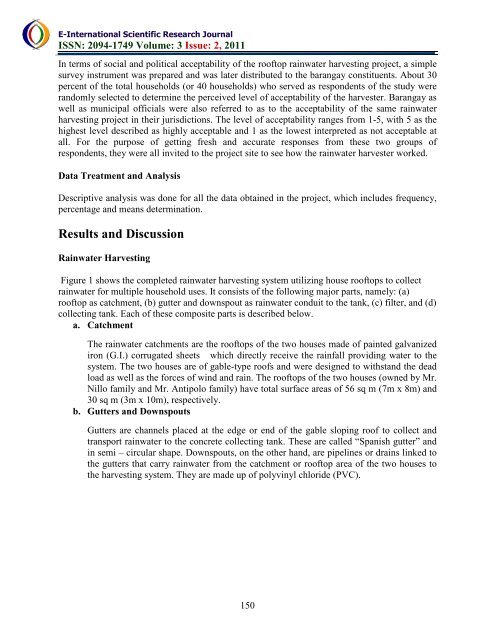download the full article here - E-International Scientific Research ...
download the full article here - E-International Scientific Research ...
download the full article here - E-International Scientific Research ...
Create successful ePaper yourself
Turn your PDF publications into a flip-book with our unique Google optimized e-Paper software.
E-<strong>International</strong> <strong>Scientific</strong> <strong>Research</strong> Journal<br />
ISSN: 2094-1749 Volume: 3 Issue: 2, 2011<br />
In terms of social and political acceptability of <strong>the</strong> rooftop rainwater harvesting project, a simple<br />
survey instrument was prepared and was later distributed to <strong>the</strong> barangay constituents. About 30<br />
percent of <strong>the</strong> total households (or 40 households) who served as respondents of <strong>the</strong> study were<br />
randomly selected to determine <strong>the</strong> perceived level of acceptability of <strong>the</strong> harvester. Barangay as<br />
well as municipal officials were also referred to as to <strong>the</strong> acceptability of <strong>the</strong> same rainwater<br />
harvesting project in <strong>the</strong>ir jurisdictions. The level of acceptability ranges from 1-5, with 5 as <strong>the</strong><br />
highest level described as highly acceptable and 1 as <strong>the</strong> lowest interpreted as not acceptable at<br />
all. For <strong>the</strong> purpose of getting fresh and accurate responses from <strong>the</strong>se two groups of<br />
respondents, <strong>the</strong>y were all invited to <strong>the</strong> project site to see how <strong>the</strong> rainwater harvester worked.<br />
Data Treatment and Analysis<br />
Descriptive analysis was done for all <strong>the</strong> data obtained in <strong>the</strong> project, which includes frequency,<br />
percentage and means determination.<br />
Results and Discussion<br />
Rainwater Harvesting<br />
Figure 1 shows <strong>the</strong> completed rainwater harvesting system utilizing house rooftops to collect<br />
rainwater for multiple household uses. It consists of <strong>the</strong> following major parts, namely: (a)<br />
rooftop as catchment, (b) gutter and downspout as rainwater conduit to <strong>the</strong> tank, (c) filter, and (d)<br />
collecting tank. Each of <strong>the</strong>se composite parts is described below.<br />
a. Catchment<br />
The rainwater catchments are <strong>the</strong> rooftops of <strong>the</strong> two houses made of painted galvanized<br />
iron (G.I.) corrugated sheets which directly receive <strong>the</strong> rainfall providing water to <strong>the</strong><br />
system. The two houses are of gable-type roofs and were designed to withstand <strong>the</strong> dead<br />
load as well as <strong>the</strong> forces of wind and rain. The rooftops of <strong>the</strong> two houses (owned by Mr.<br />
Nillo family and Mr. Antipolo family) have total surface areas of 56 sq m (7m x 8m) and<br />
30 sq m (3m x 10m), respectively.<br />
b. Gutters and Downspouts<br />
Gutters are channels placed at <strong>the</strong> edge or end of <strong>the</strong> gable sloping roof to collect and<br />
transport rainwater to <strong>the</strong> concrete collecting tank. These are called “Spanish gutter” and<br />
in semi – circular shape. Downspouts, on <strong>the</strong> o<strong>the</strong>r hand, are pipelines or drains linked to<br />
<strong>the</strong> gutters that carry rainwater from <strong>the</strong> catchment or rooftop area of <strong>the</strong> two houses to<br />
<strong>the</strong> harvesting system. They are made up of polyvinyl chloride (PVC).<br />
150

















